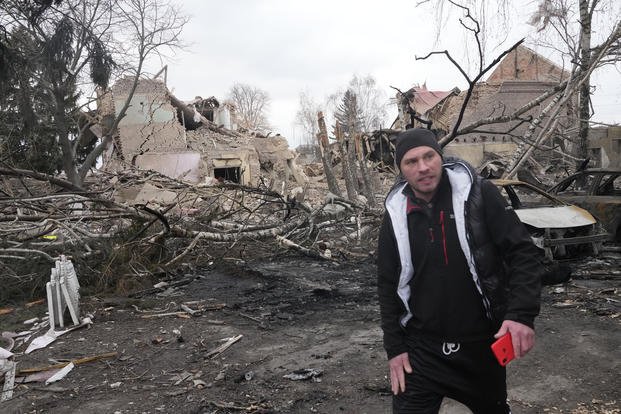The military's U.S. European Command has become the organizer of a global coalition of nations sending weapons and security aid to Ukraine as it fends off Russia's efforts to conquer the country.
The command, based in Germany under Air Force Gen. Tod Wolters, is coordinating shipments to the war zone from 14 countries. That includes the latest $350 million in aid from the U.S., as well as newly pledged support from Germany and Sweden, as outrage over Russian President Vladimir Putin's move on Ukraine intensifies.
Ukrainians, who so far had managed an effective resistance to the Russians, are already well-trained on equipment such as anti-tank weapons and had been able to distribute the aid where needed on the front lines as of Friday, a senior U.S. defense official said.
Read Next: Ukraine War Sparks Call for Billions More in Pentagon Funding
"I think all of us have been tremendously impressed by how effectively the Ukrainian armed forces have been using the equipment that we've provided them," the defense official said. "And I think Kremlin watchers have also been surprised by this, at how they have slowed the Russian advance and performed extremely well on the battlefield."
The aid from the U.S. and others has included Javelin guided anti-tank missiles, which could put Russian armor in jeopardy, and reportedly Stinger air defense missiles to take out Russian piloted aircraft or drones. Countries have also been sending small arms, body armor, helmets and food rations.
Ukraine managed to hold approaching Russian forces at bay north of the capital Kyiv this week. For days, Putin's military waged missile attacks on the country and attempted to push closer to key cities, but it was unable to capture many or take control of Ukraine's airspace due to the resistance of Ukraine President Volodymyr Zelensky's forces.
Amid the fighting, European Command tapped into a liaison officer network among allies and partner nations to coordinate support to Zelensky. The U.S. and NATO have bolstered forces along the alliance's eastern European flank, including Poland, Romania and the Baltic states, but have made clear that they will not intervene militarily in the conflict.
"They are leveraging that [network] to build this coordination cell to be able to have real-time understanding of what allies are prepared to provide and how they might be able to get it to Ukraine, and common understanding of the Ukrainian requirements," said the defense official, who spoke to reporters on the condition of anonymity.
The command is working specifically with the U.K. on how to deliver the weapons across borders and into a conflict that has raised the specter of Russia using its nuclear arsenal, after Putin ordered those forces on alert Sunday. The U.S. has declined to provide many details about the specific amounts of weapons and security aid or how it is getting into Ukraine, due to concerns it could be useful to the Russians on the battlefield.
There has been no indication that Russia has tried to disrupt the flow of arms, despite its public condemnation of the support, and the speed of deliveries was being ratcheted up significantly, the defense official said.
President Joe Biden has approved more than $1 billion worth of security aid to be drawn from the U.S. military arsenal and sent to Ukraine over the past year. About 70% of the latest tranche of $350 million in aid approved by Biden last week had already arrived in the country, and most of the remainder was expected to be delivered within the next week.
Putin's invasion came after he spent nearly a year massing forces on Ukraine's border, yet still shocked the world, prompting some European nations to reverse prior policies on weapons aid. It has also led to speculation about the further expansion of NATO and the start of a new Cold War with Russia.
Last week, both Germany and Sweden announced they would join other nations in sending weapons to Ukraine. Berlin, which previously prohibited such aid, pledged 1,000 anti-tank weapons and 500 Stinger missiles, and Sweden said it would send 5,000 anti-tank weapons, along with other military aid, according to Reuters.
-- Travis Tritten can be reached at travis.tritten@military.com. Follow him on Twitter @Travis_Tritten.













